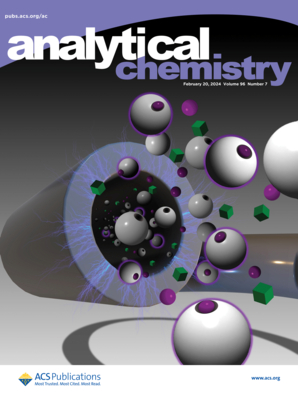基于核磁共振快速评估血清样品中癌症相关蛋白糖基化
IF 6.7
1区 化学
Q1 CHEMISTRY, ANALYTICAL
引用次数: 0
摘要
血清和血浆的核磁共振(NMR)光谱显示由代谢物、脂蛋白和与急性期蛋白共价连接的n -聚糖的n -乙酰甲基产生的信号。这些糖信号通常被称为糖蛋白A (GlycA)和糖蛋白B (GlycB),来自n -乙酰基甲基,并被提出作为生物标志物,最初用于心血管疾病,但也用于其他炎症状况。为了检测聚糖共振,已经提出了j编辑,扩散和弛豫过滤核磁共振波谱(JEDI)来抑制脂蛋白信号。然而,JEDI仅限于测量那些乙酰基信号,而所有其他聚糖共振都无法观察到。为了改进糖蛋白谱,吡喃糖环质子产生的信号是必不可少的。在这里,我们展示了如何使用选择性频率激发结合标量耦合滤波来显著增加在血清和血浆样品的核磁共振光谱中观察到的n -聚糖信号的数量,从而在不到30分钟的时间内促进糖基化分析。这种方法可以选择性地检测主要n -聚糖的唾液化、半乳糖化、n -乙酰氨基葡萄糖化和聚焦化,并在一定程度上检测n -聚糖的分支复杂性。值得注意的是,也可以观察到唾液化和非唾液化的Lewisx和Lewisa抗原。Lewisa抗原是一种公认的癌症生物标志物,称为CA19-9。9个分离血清糖蛋白的核磁共振糖基化谱与建立良好的UHPLC-MS分析结果非常吻合。所提出的核磁共振方法便于糖蛋白生物标志物的检测,而无需对血清或血浆进行酶处理,并提供了33例肝细胞癌患者样本的稳健读出。本文章由计算机程序翻译,如有差异,请以英文原文为准。

Fast NMR-Based Assessment of Cancer-Associated Protein Glycosylations from Serum Samples
Nuclear magnetic resonance (NMR) spectra of blood serum and plasma show signals arising from metabolites, lipoproteins, and N-acetyl methyl groups of N-glycans covalently linked to acute-phase proteins. These glycan signals often called glycoprotein A (GlycA) and glycoprotein B (GlycB) arise from N-acetyl methyl groups and have been proposed as biomarkers, initially for cardiovascular diseases, but also for other inflammatory conditions. For the detection of glycan resonances, J-edited, diffusion, and relaxation filtered NMR spectroscopy (JEDI) has been proposed to suppress the lipoprotein signals. JEDI is however limited to measure those acetyl signals, whereas all other glycan resonance cannot be observed. For improved glycoprotein profiling, the signals arising from the pyranose ring protons are essential. Here, we show how selective frequency excitation combined with scalar coupling filtering can be used to dramatically increase the number of N-glycan signals observable in NMR spectra of serum and plasma samples, facilitating glycosylation profiling in less than 30 min. This approach grants selective detection of sialylation, galactosylation, N-acetylglucosaminylation, and fucosylation of dominant N-glycans and, to some extent, N-glycan branching complexity. Notably, sialylated and nonsialylated Lewisx and Lewisa antigens can also be observed. Lewisa antigen is well established as a cancer biomarker, known as CA19-9. NMR glycosylation profiles from nine isolated serum glycoproteins show excellent agreement with well-established UHPLC-MS analysis. The proposed NMR method facilitates the detection of glycoprotein biomarkers without the need for enzymatic treatment of serum or plasma and provides a robust read-out as exemplified by samples from 33 patients with hepatocellular carcinoma.
求助全文
通过发布文献求助,成功后即可免费获取论文全文。
去求助
来源期刊

Analytical Chemistry
化学-分析化学
CiteScore
12.10
自引率
12.20%
发文量
1949
审稿时长
1.4 months
期刊介绍:
Analytical Chemistry, a peer-reviewed research journal, focuses on disseminating new and original knowledge across all branches of analytical chemistry. Fundamental articles may explore general principles of chemical measurement science and need not directly address existing or potential analytical methodology. They can be entirely theoretical or report experimental results. Contributions may cover various phases of analytical operations, including sampling, bioanalysis, electrochemistry, mass spectrometry, microscale and nanoscale systems, environmental analysis, separations, spectroscopy, chemical reactions and selectivity, instrumentation, imaging, surface analysis, and data processing. Papers discussing known analytical methods should present a significant, original application of the method, a notable improvement, or results on an important analyte.
 求助内容:
求助内容: 应助结果提醒方式:
应助结果提醒方式:


